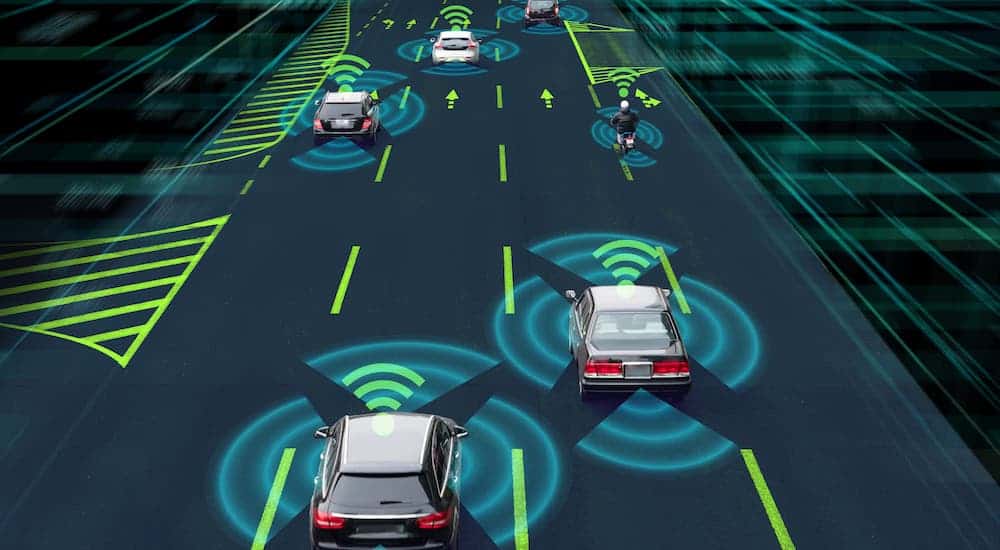Can you guess how many airbags were standard on vehicles a decade ago? Most vehicles came with two front airbags, which is a stark contrast to vehicles today that have anywhere between four to ten airbags built into the interior cabin to ensure the safety of the driver and every passenger, whether they are sitting in the front or rear seats. But what else has changed when it comes to safety in the automotive industry? When you go to your used car dealer and start looking for cars with excellent safety features, what do you want most? What are the best safety features to enter the market in the last decade? Well, let’s take a look and see.
Electronic Stability Control
Electronic Stability Control (ESC) starts our list as one of the most significant improvements to car safety over the last decade. ESC is designed to electronically detect when the vehicle loses traction between the tires and the road. When this occurs, the ESC system applies the brakes to ensure the driver maintains control and to prevent the vehicle from skidding. While this technology has been around for over a decade, it did not become a required safety feature on all new vehicles until September 1, 2011.
Rear-View Camera
Does your car, truck, or SUV have a rear-view camera? If so, you know firsthand how easy the camera makes it to back out of the garage or to leave a parking space by alerting you to vehicles or other objects directly behind your vehicle. After decades of rear-oriented accidents, the automotive industry discovered that the cause of most of these accidents was poor visibility behind the vehicle. The solution was to make rear-view cameras a required safety feature in newer models starting May 1, 2018. This makes rear-view camera technology one of the newest additions to the modern automotive industry.

Blind Spot Detection
Much like the visibility issues associated when a vehicle is in reverse, drivers typically struggle with blind spots around their vehicle. While blind spots are unavoidable simply because of vehicle construction, the industry found a remedy to an ongoing problem – blind spot detection. Utilizing digital cameras or sensors, blind spot detection technology monitors the vehicle’s blind spots and alerts the driver if a vehicle is in an adjacent lane. Although the alert is not yet a required safety feature, it usually comes standard on newer models and has greatly reduced the number of accidents when merging or changing lanes.
Forward Collision Prevention
Forward Collision Prevention technology is another huge advancement in safety features added to vehicles over the last decade. This technology includes driver-assistance features like Forward Collision Warning, Automatic Emergency Braking, and Pedestrian Automatic Emergency Braking. Each of these features is designed to give drivers greater confidence behind the wheel and ensure not only their safety but the safety of other drivers as well.
Forward Collision Warning technology detects potential collisions ahead and warns the driver to prevent or minimize the impact. Automatic Emergency Braking, which is now standard on almost all new vehicles, automatically applies the brakes when a forward collision is unavoidable. Pedestrian Automatic Emergency Braking is often an upgraded feature on modern vehicles and is designed to detect pedestrians crossing in front of the vehicle. The tool not only warns the driver but applies the brakes if a collision with the pedestrian is imminent.
Lane Assist
Just as forward collision technology works to prevent forward collisions, lane-keeping technology is designed to prevent accidents when changing lanes. For example, most vehicles now come standard with a Lane Departure Warning, which alerts drivers when the vehicle unintentionally drifts out of its lane without the use of a turn signal. The Lane Keeping safety feature takes this technology a step further by monitoring the vehicle’s position in the lane and making the necessary adjustments – correcting the steering, accelerating, or braking – to return the vehicle to its designated lane. This prevents accidents like sideswiping and rollovers.

Dynamic Brake Support and Crash Imminent Braking
Sometimes, drivers misjudge a potential collision and fail to apply the brakes hard enough or in time. This is where technology like Dynamic Brake Support and Crash Imminent Braking comes into play. Dynamic Brake Support is designed to enhance the driver’s braking if the brakes are not applied hard enough. If the driver fails to apply the brakes in time, Crash Imminent Braking takes over and automatically applies the brakes to avoid or reduce the severity of an impending collision.
Automatic Crash Notification
Your adrenaline instantly spikes when you’re involved in an accident. Immediately after impact, you must take inventory of yourself and the well-being of your passengers. You also need to alert 911 of the incident. All this occurs just minutes after a collision, which is why newer vehicles include technology like Automatic Crash Notification that alerts 911 the instant the crash occurs.
Vehicles equipped with this technology use sensors to detect when a collision has occurred through cues like if an airbag has deployed or there’s been a sudden deceleration of the vehicle. When this occurs, the system automatically connects to an operator who immediately communicates with the driver of the vehicle. While gathering pertinent information about the driver, vehicle, and passengers, the operator alerts 911 to deploy emergency responders to the scene.
This is one of the best safety features to debut over the last decade. Every moment counts after an accident, and even the difference of a minute could mean life, disability, or death. Automatic crash notification technology saves precious time by alerting emergency responders immediately after the crash. This is especially valuable in tragic accidents where the driver or passengers are unconscious and unable to make that life-saving call to 911.
Why Safety Matters
Human error is the cause of most vehicle crashes. Modern technology like smartphones are great for keeping individuals connected, but they can also be life-threatening distractions behind the wheel. The automotive industry recognizes this dilemma and is focused on innovation as they release new technology to ensure drivers can easily sync their smartphones to their cars and utilize voice recognition software to ensure their eyes stay on the road and their hands stay on the wheel. But this innovation extends even further beyond connectivity to advanced safety features.
Over the last decade, vehicle safety features have seen exceptional advancements that not only ensure the driver’s safety but enhance their overall driving experience. Technology like rear-view cameras and blind spot monitoring takes the guesswork out of backing up, just as lane-keeping assist features prevent sideswiping collisions and rollovers when drivers unintentionally veer from the designated lane. These tools are vital in reducing the number of collisions, which is why organizations like the National Highway Transportation Safety Administration are going to great lengths to set new safety requirements for modern vehicles.
While new vehicles come standard with a variety of advanced safety features, shopping for a used model can be trickier. It’s important to ask your dealer what safety features the model you are looking at has, so you can be aware of how your vehicle can help keep you safe. Just because you are buying used doesn’t mean you are going to be missing out on safety features. Rapid innovations in technology are making cars, even used models, safer than ever to drive.



